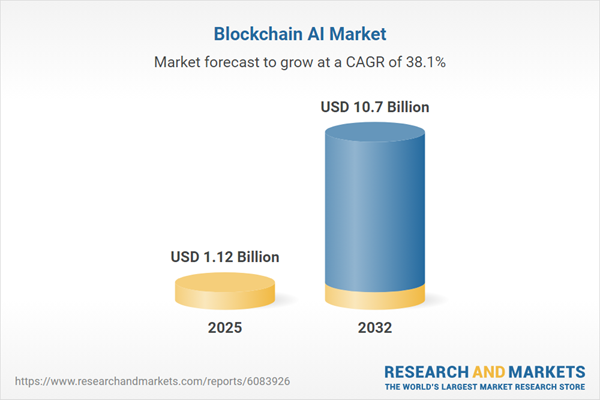Speak directly to the analyst to clarify any post sales queries you may have.
The Blockchain AI Market is at the forefront of digital transformation, redefining operational standards as businesses increasingly integrate advanced blockchain and artificial intelligence (AI) solutions to drive innovation, efficiency, and new value opportunities.
Market Snapshot: Blockchain AI Market Growth and Trends
According to recent research, the Blockchain AI Market grew from USD 808.13 million in 2024 to USD 1.12 billion in 2025. Projected to maintain a strong CAGR of 38.12%, the market is expected to reach USD 10.70 billion by 2032.
This impressive expansion reflects rapidly rising adoption across sectors pursuing greater data integrity, intelligent automation, and enhanced transparency to gain a competitive edge.Scope & Segmentation: Blockchain AI Market Structure
- Component: Services (including consulting, integration & implementation, support & maintenance), software (analytics tools, development platform, security solutions)
- End User: BFSI (banking, capital markets, insurance), government (defense, public administration, smart city), healthcare (healthcare providers, payers, pharma), IT & telecom (hardware vendors, IT services providers, telecom operators), retail & e-commerce (online retail, specialty retail, supermarkets)
- Deployment Mode: Cloud (private cloud, public cloud), hybrid, on premises
- Application: Data analytics (fraud detection, predictive analytics), identity management, payment processing (cross border payment, real time settlement), smart contracts (contract lifecycle management, self executing contracts), supply chain management (counterfeit detection, traceability)
- Region: Americas (North America – United States, Canada, Mexico; Latin America – Brazil, Argentina, Chile, Colombia, Peru), Europe, Middle East & Africa (Europe – United Kingdom, Germany, France, Russia, Italy, Spain, Netherlands, Sweden, Poland, Switzerland; Middle East – United Arab Emirates, Saudi Arabia, Qatar, Turkey, Israel; Africa – South Africa, Nigeria, Egypt, Kenya), Asia-Pacific (China, India, Japan, Australia, South Korea, Indonesia, Thailand, Malaysia, Singapore, Taiwan)
- Industry Players: Amazon Web Services, Inc., Microsoft Corporation, Google LLC, International Business Machines Corporation, Alibaba Group Holding Limited, SingularityNET Foundation, Fetch AI Limited, Ocean Protocol Foundation AG, Numerai PBC, DeepBrain Chain Co., Ltd
Key Takeaways: Strategic Trends and Insights
- The convergence of blockchain and AI is rapidly reshaping business models by facilitating real-time, secure, and tamper-resistant transactions accompanied by intelligent automation and predictive analytics.
- Early adopters are leveraging combined blockchain and AI architectures to streamline complex workflows, improve resource allocation, and address emerging security risks in a proactive manner.
- Multi-region market movement reflects specific regulatory approaches and digital innovation priorities, with robust ecosystems emerging across the Americas, EMEA, and Asia-Pacific to support diverse applications from finance to healthcare.
- Ongoing integration efforts include collaboration among technology providers, enterprises, and startups, fueling continuous platform enhancements and sector-specific solutions for compliance, scalability, and fraud detection.
- Industry leaders are focusing on interoperability and standardization to support seamless data sharing and scale up deployments across legacy systems and new market segments.
Tariff Impact: Responding to U.S. Adjustments
Recent U.S. tariff adjustments are prompting blockchain AI supply chains to prioritize localized sourcing, vertical integration, and onshore data center innovation. Organizations are renegotiating cross-border technology agreements and adapting intellectual property strategies to offset increased procurement costs. This shift is fostering partnerships and talent development programs that strengthen domestic capabilities in both blockchain and AI engineering.
Methodology & Data Sources
This report synthesizes insights from primary interviews with executives and industry specialists, quantitative surveys of adopters, and extensive secondary analysis of regulatory filings, corporate disclosures, and technical benchmarks. Robust validation processes and statistical analysis ensure reliable, decision-oriented intelligence for stakeholders.
Why This Report Matters for Senior Decision-Makers
- Enables clear, actionable understanding of how blockchain AI integration can reshape operational frameworks, supporting strategic investment planning.
- Guides leaders on leveraging new market opportunities and managing regulatory, supply chain, or technical risks associated with blockchain AI adoption.
- Supports data-driven prioritization by mapping leading vendors, evolving applications, and regional expansion strategies, empowering effective executive decision-making.
Conclusion
The Blockchain AI Market is defined by rapid evolution, regulatory adaptation, and strategic partnership activity across global regions. Leaders who prioritize technology integration and market alignment position their organizations to capitalize on blockchain and AI advancements for future growth.
Table of Contents
3. Executive Summary
4. Market Overview
7. Cumulative Impact of Artificial Intelligence 2025
Companies Mentioned
The companies profiled in this Blockchain AI market report include:- Amazon Web Services, Inc.
- Microsoft Corporation
- Google LLC
- International Business Machines Corporation
- Alibaba Group Holding Limited
- SingularityNET Foundation
- Fetch AI Limited
- Ocean Protocol Foundation AG
- Numerai PBC
- DeepBrain Chain Co., Ltd
Table Information
| Report Attribute | Details |
|---|---|
| No. of Pages | 181 |
| Published | November 2025 |
| Forecast Period | 2025 - 2032 |
| Estimated Market Value ( USD | $ 1.12 Billion |
| Forecasted Market Value ( USD | $ 10.7 Billion |
| Compound Annual Growth Rate | 38.1% |
| Regions Covered | Global |
| No. of Companies Mentioned | 11 |









